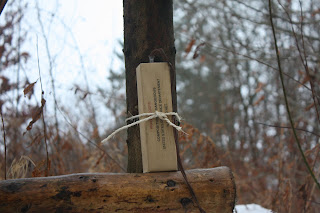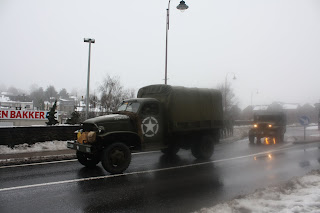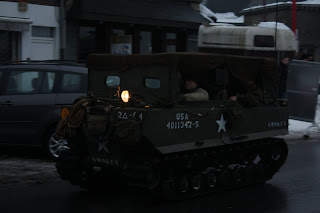This past weekend marked the 65th Anniversary of the Battle of the Bulge, one of the most famous battles that occurred during WWII. To commemorate the Allied victory and hardship the troops endured while holding off the German aggression, one of the last survivors from the battle, Maurice Sperandieu founded the Bastogne Historical Walk. For the past 33 years this historic walk retraces the defensive lines held by the American soldiers during the Battle of the Bulge. Thousands of participants have come out each year to walk one of four distances: 7km, 14km, 20km, or 28km. The exciting part of the walk is the reenacted scenes found throughout all four distances and the hundreds of volunteers that dress in authentic 1944 military gear.
The Battle of the Bulge took place from Dec. 14, 1944 to January 25, 1945, and was a major German offensive launched toward the end of WWII. The official name was the Ardennes-Alsace Campaigne, but was known by most as the Battle of the Bulge. It was referred to by this name because the "bulge" was the initial incursion the Germans put into the Allies' line of advance (as seen below on the map).

What the map does not show are the conditions that the men endured as they fought off the advancing German army: heavy snow, bitter cold, no real winter clothing to speak of, minimal food and amunition supplies, and almost no medical support. If you have watched the movie 'Band of Brothers' that follows the 101st Airborne and Combat Command Company B, you will no doubt recall the extreme conditions these men fought through to defend the village of Bastogne and in effect stop the advancing German army. The Battle of the Bulge was the bloodiest of the battles the U.S. forces experienced in WWII. Of the 800,000+ men that fought in the battle, over 19,000 were killed, some 47,500 were wounded, and approximately 23,000 were either captured or are considered missing.
Going into the event, we expected to find a few hundred people there that were crazy like us who thought hiking in the freezing cold and snow-covered ground was a good way to pass a Saturday. We underestimated the attendance by thousands. There were people from all over dressed in either today's moden military dress or the authentic uniforms from 1944. It was an awesome sight to see servicemembers from Belgium, Germany, Luxembourg, France, Italy, and the United Kingdom participating in the event.
Here we are bundled up and ready to hit the trail.
On our way out of downtown Bastogne there were several vehicles from the era operated by men and women dressed in full authentic uniforms. You really did feel as though you were being transported back in time.
Lucky for us all four routes headed in the same direction for the first few kilometers, making it very easy to not get lost: follow the massive crowd walking down the road in somewhat single-file.
Before long we arrived to the first of many reenactment displays. What looked like a simple farm house from the outside housed a temporary Battalion or Regiment command post inside.
This particular scene was very special for me as my grandfather, who served in the Army during WWII as a radio operator for the 35th Division, was one of the many units that fought in the Battle of the Bulge.
Reviewing maps and drafting a strategy.
A temporary writing station inside the command post.
Outside the command post we ran into one of several groups participating in the walk dressed in full authentic gear.
Just down the hill from the command post and we arrived at our first look at what it was like for the men fighting in the cold winter in 1944. We arrived early enough to witness a group of 3 men digging their temporary station with pick axes (the ground was nearly frozen solid). It was then that we realized that the weather today, in the low 30's Fahrenheit and a few inches of snow, was going to help show us what it must have been like 65 years ago.....only the men did not have the modern day conveniences of wicking shirts and warm waterproof boots. Appreciation level advanced several thousands notches higher at the sight of those men digging in the dirt.
A jeep parked near the position. Everywhere you looked was authentic equipment, including this gun and helmet.
Making our way out of the first village, you can see the long line of people out for this walk.
We felt like we were transported back to 1944 as we walked behind these 3 soldiers down a country road just outside the village of Bastogne, Belgium.
I wonder if this is how it looked during the month-long battle.
Arriving at the Replacements Headquarters. Posts like this were common during the war and typically set back well behind the front lines. The title is accurate for the purpose: replacing soldiers that have fallen.
Moving out from the Replacement Headquarters and heading up a narrow "country road" to more renactment scenes. It is here that we left behind the comforts of paved road and began the several kilometers of primitive road that left us a with sincere appreciation for what those soldiers 65 years ago endured walking in the compact snow and ice.
Approaching the renactment scenes had a profound effect on us, so much that we stopped dead in our tracks. The soldiers dressed in authentic gear and then looking towards the different scenes provided a very realistic insight towards the conditions during the battle.
It is fairly easy to spot this deadly gun positioned among the trees when standing a few feet from the position. Probably not so easy to spot when you are a hundred feet away in an open field.
One guy looking out and one guy trying to stay warm. And yes, it was that cold during our hike so I doubt this soldier is acting all that much.
Another scene of a lookout while the "foxhole buddy" takes a break to warm up a drink to fight off the wet and cold conditions.
Perhaps a word play on "unexploded" and "exposed" bomb?
High explosives were tied off to various trees and strutures that added to the reality of the reencactment.
Part ingenuity, part survival. A way to stay warm and prepare some food without the danger of catching yourself and your ammunition on fire.
As we continued with our walk, we came upon a critical juncture: to take the path for the 14km walk or 20km walk. We chose the 20km walk for a few reasons. First, we did not want to miss out on any reenactment scenes and second, we figured the longer distance in the cold and snow would be more honorable to the men who fought in the battle. What we did not know at the time were two pieces of critical information. First, there were no reenactment scenes on this additional 7km loop. Bummer. Second, the path would include no pavement after the first 2km....meaning we would stumble along on the thick snow-covered trails. At one point we were crossing a wide open field and you could see for miles (or kilometers). The view was spectacular but you also felt vulnerable after witnessing the near-stealth positions that the soldiers created just inside the tree lines. After completing the loop we were both satisfied with the decision and felt this provided us with a more realistic experience than had we stuck to the "paved roads".
During our extended loop we came upon a thick forest. This is what it must have looked like to the men of the 101st Airborne as they defended the village of Bastogne during the battle. Of course there are no exploding trees nor foxholes dug.....
Completing the loop, we arrived at the next reenactment scene that included several authentic vehicles from the war.
While enjoying a warm cup of coffee and a tasty treat, we watched several authentic vehicles driving around in the parking area, including this German vehicle.
For a brief moment we considered extending our walk to the 28km distance until we looked at the time. It was approaching 1:30pm and we wanted to take in the parade and throwing of the nuts on the main street of Bastogne, both to begin around 2:30pm. So instead of gutting out the additional 8km we headed back to Bastogne. Luck was on our side as we caught the end of the parade.
Making our way down the main street we finally arrived at the de L'Hotel de ville to watch the throwing of the nuts. Why is there a ceremony involving throwing nuts by the village mayor at the participants of the event? During the Battle of the Bulge when it looked as though the 101st Airborne unit would not endure the constant attacks by the German army, the Germans sent a message to the US General McAuliffe demanding the US troops surrender. General McAuliffe responded by sending a one-word message response: NUTS....which translates into something like 'no thanks', only more "colorful".
After the event we learned the nuts being thrown were walnuts. I'm glad we opted to observe from a safe distance back.
After the ceremony we walked down to the central town square, or McAuliffe square. If you venture down there you will see the American Sherman Tank that was a part of the battle. The tank was badly damaged during a battle to liberate a nearby village (Renuament). Today it stands in honor of those from the 10th Armored Division that fought during the Battle of the Bulge and helped defend the village of Bastogne.
The last ceremony for the day was the laying of the flowers at the monuments for Patton and McAuliffe. The McAullife monument:
As stated before, we feel very fortunate to live so close to areas such as Bastogne that allow us to participate in these types of events. More, we felt privileged to be walking in the fields made famous by the Battle of the Bulge alongside members of today's military. The cold and snow were a blessing as well by providing us a better insight to the conditions of those that fought in the battle. We almost felt ashamed as we loaded into the warm vehicle and headed home to enjoy a nice warm meal that night. Those soldiers 65 years ago were cold for over a month and suffered through such unbearable conditions with minimal food and supplies. At least we knew when we would could feel our hands and face again. Those soldiers only dreamed of such luxuries.....all the while trying their best to not get killed by enemy gun fire and incoming artillery shells.
To all those service members that have endured harsh conditions as a part of their duty, a simple thank you doesn't feel like enough. So we offer that and a promise to never forget.









































Thanks for the awesome pictures. I had no idea about the historical walk in Bastogne. wish I would've known before I visited there.
ReplyDeleteTraveler's Closet: Belgium Ardennes, Bastogne
I have a keen interest in the history of the WW2 and a big fan of Band of Brothers. So I was thrilled to be standing in the same forest that band of brothers fought. But after looking at your pictures. I'm totally jealous!!! lol
It is truely amazing how foxholes remain as it was abandoned yesterday.